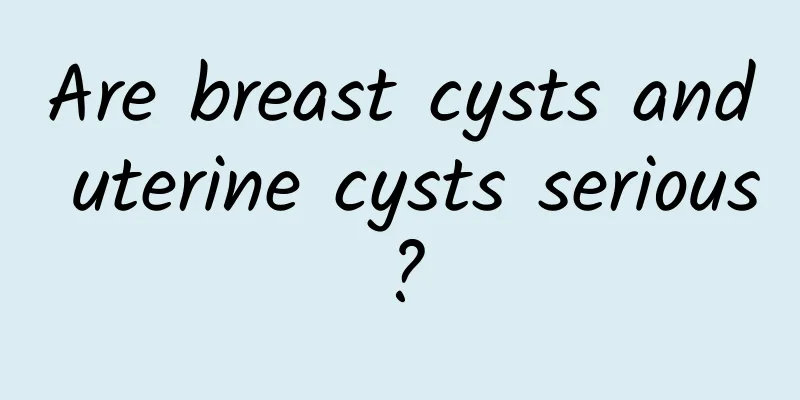Are breast cysts and uterine cysts serious?

|
Breast cysts and uterine cysts are generally not serious and are mostly benign lesions, but whether to treat or undergo surgery depends on the specific size, development and symptoms. If the cyst is small and has no obvious symptoms, it can usually be treated with observation and regular checkups after evaluation by a doctor; if the cyst develops rapidly, the symptoms are obvious, or there is a risk of cancer, intervention measures may be required. Breast cysts are often caused by fluctuations in hormone levels or degenerative changes in breast tissue, and are particularly common in women of childbearing age. Mild cysts may be asymptomatic and only found during palpation or imaging examinations; larger cysts may cause breast tenderness and discomfort when touched. When cysts cause persistent pain, rapid growth, or abnormal shape or texture, be alert to the risk of lesions. Usually, a clear diagnosis can be made through B-ultrasound and mammography, and treatment methods include aspiration of effusions, medication to regulate hormone levels (such as tamoxifen), or surgical removal. Uterine cysts mostly occur in the ovaries, cervix, or uterine cavity, mainly due to chronic inflammation, hormonal abnormalities, endocrine disorders, and other reasons. Some are asymptomatic and may be accompanied by menstrual disorders, abnormal leucorrhea, or lower abdominal pain. In severe cases, they may cause reproductive health problems. Treatments for cysts include drug therapy (such as oral contraceptives, progesterone regulation), surgery (such as laparoscopic cyst removal), or anti-inflammatory treatment to prevent further development. Breast cysts are often caused by fluctuations in hormone levels or degenerative changes in breast tissue, and are particularly common in women of childbearing age. Mild cysts may be asymptomatic and only found during palpation or imaging examinations; larger cysts may cause breast tenderness and discomfort when touched. When cysts cause persistent pain, rapid growth, or abnormal shape or texture, be alert to the risk of lesions. Usually, a clear diagnosis can be made through B-ultrasound and mammography, and treatment methods include aspiration of effusions, medication to regulate hormone levels (such as tamoxifen), or surgical removal. Uterine cysts mostly occur in the ovaries, cervix, or uterine cavity, mainly due to chronic inflammation, hormonal abnormalities, endocrine disorders, and other reasons. Some are asymptomatic and may be accompanied by menstrual disorders, abnormal leucorrhea, or lower abdominal pain. In severe cases, they may cause reproductive health problems. Treatments for cysts include drug therapy (such as oral contraceptives, progesterone regulation), surgery (such as laparoscopic cyst removal), or anti-inflammatory treatment to prevent further development. For patients with breast cysts and uterine cysts, regular physical examinations and B-ultrasound monitoring are very necessary. Usually, the cycle is six months to one year. At the same time, maintaining a healthy diet, regular work and rest, and avoiding excessive obesity or excessive stress will help reduce the risks associated with cysts. If symptoms such as persistent pain, irregular bleeding, and rapid enlargement of the cyst occur, you should see a doctor as soon as possible, and have a professional doctor diagnose and clarify the treatment plan. |
<<: What are the Chinese patent medicines for treating liver depression and spleen deficiency?
>>: How many days of pregnancy can painless abortion be performed
Recommend
Introduction to the causes of vulvar leukoplakia that female friends should know
The cause of vulvar leukoplakia is a matter of gr...
Is it cheap to treat pelvic peritonitis?
The cost of treating pelvic peritonitis varies fr...
Can cervical warts be cured?
With the increase of unclean sex life, the number...
Can women with cervical erosion take medicine? 5 best ways to treat cervical erosion
With the development of medical technology, there...
Crazy about this pot during Chinese New Year! Low-calorie matcha soy milk hotpot without gaining weight
During the Chinese New Year, people gather around...
How to calculate menstrual period after abortion?
Experts say that after an abortion, the endometri...
What are the symptoms of female uterine fibroids? Will female uterine fibroids cause infertility?
When it comes to female uterine diseases, uterine...
Experts teach you how to prevent cervical hypertrophy.
How to prevent cervical hypertrophy? Mild cervica...
Precautions for patients with premature ovarian failure who experience amenorrhea
Premature ovarian failure can lead to amenorrhea ...
Environmental Protection Agency plans to add 3 more substances to the list of controlled substances
Drinking water helps eliminate toxins from the bo...
How to prevent Bartholinitis?
Bartholinitis is mainly caused by bacterial infec...
Does ovulation bleeding mean that ovulation has occurred?
Ovulation bleeding may mean that ovulation has oc...
What do miscarriage contractions feel like and what are the causes of miscarriage?
After a miscarriage, in order to promote the reco...
OL weight loss technique! Fitness coach recommends 3 tricks to lose weight easily by watching TV series
After a hard day at work, many office ladies get ...
Is ovarian cyst related to staying up late?
Is ovarian cyst related to staying up late? Wheth...









